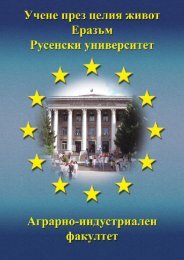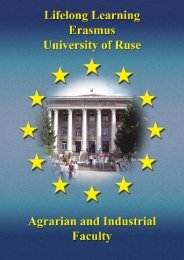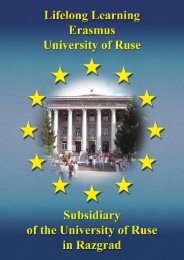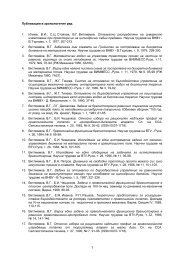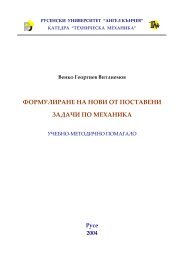Erasmus ECTS Information Package
Erasmus ECTS Information Package
Erasmus ECTS Information Package
You also want an ePaper? Increase the reach of your titles
YUMPU automatically turns print PDFs into web optimized ePapers that Google loves.
<strong>Erasmus</strong> <strong>ECTS</strong> <strong>Information</strong> <strong>Package</strong><br />
Faculty of EEEA<br />
3167 Control of Electromechanical Systems – 1<br />
<strong>ECTS</strong> credits: 5<br />
Weekly classes: 2lec + 0sem + 2labs + 0ps + 1ca<br />
Assessment: continuous assessment<br />
Type of exam: written<br />
Departments involved:<br />
Department of Automatics and Mechatronics<br />
Faculty of Electrical Engineering, Electronics and Automation<br />
Lecturers:<br />
1. Assoc. Prof. Emil Konstantinov Kuzmanov, MEng, PhD, Dept. of Automatics and Mechatronics,<br />
tel.: 082 888 269, E-mail: ekkuzmanov@uni-ruse.bg<br />
Abstract:<br />
The aim of the course is to introduce the students from the department of AICT to the mechanics of electromotion,<br />
the electromechanical properties of induction motors, the power engineering of electro-motion and<br />
the bases of dynamics of electro-motion. The discipline is based on the knowledge, acquired during the<br />
following courses: Theory of Electrical Engineering, Electromechanical devices, and is also connected to<br />
Control of Electromechanical Systems-2.<br />
Course content:<br />
Basic equation of the electro-motion. Mechanical characteristics of the manufacturing mechanisms.<br />
Mechanical and electromechanical characteristics of current electricity motors. Mechanical and<br />
electromechanical characteristics of induction motors. Stopping of electric motors. Speed control of electromotion.<br />
Transitional processes in electro-motion. Thermal processes in electro-motion. Choice of power<br />
capacity of electric motors.<br />
Teaching and assessment:<br />
Student assessment takes place both during lectures and practice classes and is combined with the results<br />
from the preliminary oral exam and 2 tests (one in the middle, and one at the end of the term). Point system<br />
for assessing students’ knowledge is also an option. If a student gets a poor mark on the first test, on the<br />
second test he should answer an additional question, based on the first-test material. If a student gets a<br />
poor mark on the second test, he has to go in for a supplementary exam.<br />
3168 Computer control systems - I<br />
ECST credits: 6 Weekly classes: 2lec + 0sem + 3labs + 0ps + 0.5p<br />
Assessment: exam<br />
Type of exam: written<br />
Departments involved:<br />
Department of Automatics and Mechatronics<br />
Faculty of Electrical Engineering, Electronics and Automation<br />
Lecturers:<br />
1. Assoc. Prof. Lidiya Hristova Georgieva, MEng, PhD, Dept. of Computing, tel.: 082 888 380,<br />
E-mail: LGeorgieva@ecs.uni-ruse.bg<br />
2. Principal Assistant Nikolay Valov, MEng, Dept. of Automatics and Mechatronics,<br />
tel.: 082 888 266, E-mail: npvalov@uni-ruse.bg<br />
Abstract:<br />
The course is a part of a group of subjects, which give knowledge in the field of microprocessors. Course<br />
prerequisites include the subjects Analog and Digital Electronics and Microprocessors. The organization,<br />
structure, functional algorithms and interaction between parts of the computer control systems are<br />
discussed.<br />
Course content:<br />
Organization of a computer control system. A/D and D/A converters. Structure of microprocessors and<br />
single - chip microcomputers. Memory organization: hierarchy, permanent and data memory, logic structure,<br />
address decoding etc. Input and output organization: software and hardware control of I/O, interrupt<br />
mechanism, special interface chips. Computer control systems design on the base of microprocessors and<br />
single - chip computers.<br />
Teaching and assessment:<br />
The lectures and the labs are once a week. The exam is written. The students write on two questions from<br />
the course syllabus and solve a small task using assembly language for single-chip microcomputers, which<br />
is used in the control system. The final mark is formed considering the results from the semester and the<br />
exam.<br />
132



